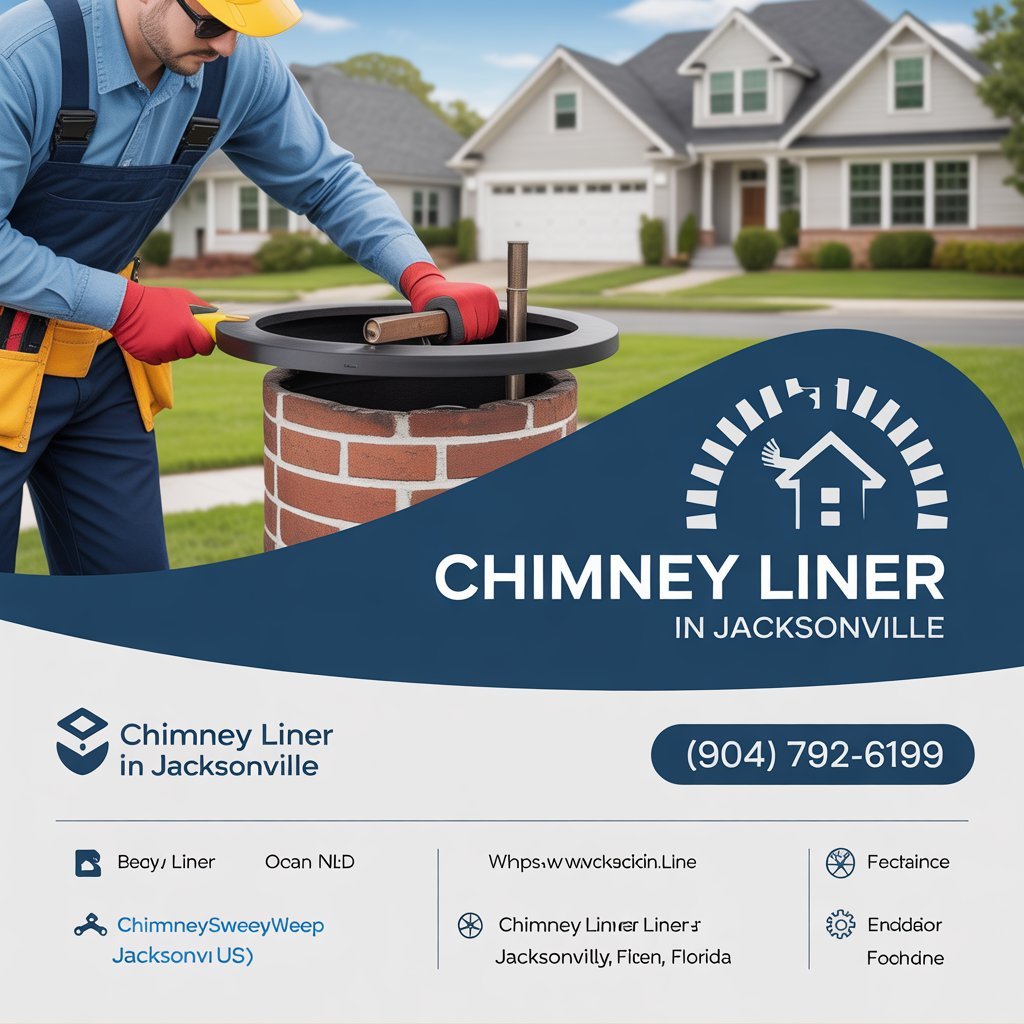If you’ve got a fireplace or wood stove, chances are your chimney has a liner or at least it should. Chimney liners are one of those things most homeowners don’t think about until there’s a problem. But the truth is, a good chimney liner can make all the difference in how efficiently, safely, and cleanly your system runs.Whether you’re dealing with an old chimney that needs relining or you’re simply curious about what’s inside that brick column on your roof, this guide is for you. We’ll break down the five most common types of chimney liners, what they’re best for, and a few things to watch out for. This info is especially helpful if you’re considering a new chimney liner in Jacksonville, where local weather and salt air can take a toll on chimney materials.
So, What’s a Chimney Liner, Anyway?
Let’s start simple. A chimney liner is a protective layer inside your chimney that helps vent smoke, gases, and heat from your fireplace, stove, or furnace. It keeps those byproducts from damaging the chimney walls and helps prevent dangerous gases like carbon monoxide from leaking into your home.Without a liner, your chimney is just a brick tunnel one that can crack, leak, or overheat. That’s a serious safety risk. Now that we’ve got the basics down, let’s dive into the five main types of chimney liners and what makes each one unique.
1. Clay Tile Chimney Liners
These are the old-school classics. If you’ve got a house built before the 1970s, there’s a good chance your chimney is lined with clay tiles.
Pros:
- Inexpensive and widely available
- Lasts 50+ years if maintained
- Works well with wood-burning fireplaces
Cons:
- Can crack under extreme heat changes
- Hard to repair if damaged
- Not ideal for gas appliances
Best For:
Traditional open fireplaces and wood stoves in milder climates. In Jacksonville, the freeze-thaw cycle isn’t as intense, but moisture can still affect tile longevity.
2. Metal Chimney Liners (Stainless Steel)
Stainless steel liners are the go-to choice for many modern chimney installations and relining projects.
Pros:
- Extremely durable and corrosion-resistant
- Easy to install in older chimneys
- Works with all fuel types: wood, gas, oil, pellets
Cons:
- More expensive than clay
- Needs insulation to perform well
Best For:
Retrofitting older chimneys or adding a new liner to match a modern heating system. Especially useful for chimney liner installations in Jacksonville, where the salt air can corrode lesser materials.
3. Aluminum Chimney Liners
Aluminum liners are lightweight and cheaper than stainless steel, but they come with some pretty specific limitations.
Pros:
- Affordable
- Easy to install
- Lightweight
Cons:
- Only suitable for gas appliances
- Not as durable as stainless steel
- Can corrode easily in humid or coastal areas
Best For:
Gas fireplaces or gas water heaters not for wood-burning systems. Probably not the best long-term choice for Jacksonville due to humidity and salt exposure.
4. Cast-In-Place Chimney Liners
This method involves pouring a cement-like material inside the chimney to create a seamless, insulated liner.
Pros:
- Excellent insulation
- Strengthens older, damaged chimneys
- Long-lasting (up to 50 years)
Cons:
- Expensive and labor-intensive
- Not a DIY project
- Takes time to cure
Best For:
Older brick chimneys with structural issues. Great when you want to restore strength and efficiency all at once.
5. Thermocrete (Spray-On) Chimney Liners
These liners are made by spraying a ceramic coating onto the inside of the chimney, creating a smooth, sealed layer.
Pros:
- Seals small cracks and improves airflow
- Resists moisture and corrosion
- Safe for all fuel types
Cons:
- Needs professional installation
- May not be suitable for severely damaged flues
Best For:
Chimneys that don’t need a full reline but could use a little sealing and protection. Works well in damp environments like Jacksonville, especially with gas appliances.
Quick Comparison Table
| Chimney Liner Type | Fuel Type | Durability | Cost Level | Best Used For |
| Clay Tile | Wood | High (if intact) | $ | Traditional fireplaces |
| Stainless Steel | All fuels | Very High | $$$ | Retrofitting older chimneys |
| Aluminum | Gas only | Moderate | $$ | Budget gas systems |
| Cast-In-Place | All fuels | Very High | $$$$ | Old chimneys needing reinforcement |
| Spray-On (Thermocrete) | All fuels | High | $$$ | Sealing minor cracks & moisture areas |
A Word from the Pros
“If you live near the coast like we do here in Jacksonville, always go for corrosion-resistant materials. Salt air doesn’t play nice with cheap liners,” says Tom Reynolds, a chimney technician with 20+ years of experience in North Florida.
That’s sound advice, especially for homeowners in humid or rainy areas. You don’t want to save money today and end up with a repair bill tomorrow.
Final Thoughts: Choose Smart, Stay Safe
Picking the right chimney liner is more important than it might seem. The right one keeps your home safer, your system running better, and your maintenance costs lower. When in doubt, talk to a certified chimney expert who knows your region. They can inspect your chimney, recommend the best type of liner, and even spot early signs of damage.Whether you’re upgrading an old system or installing a brand new one, always keep your location in mind. For folks living in coastal Florida, it’s especially important to choose materials that stand up to moisture, heat, and salty air. If you’re planning any chimney upgrades or installations, always work with a licensed professional familiar with chimney liner installations in Jacksonville.
Read more:Chimney Sweep
